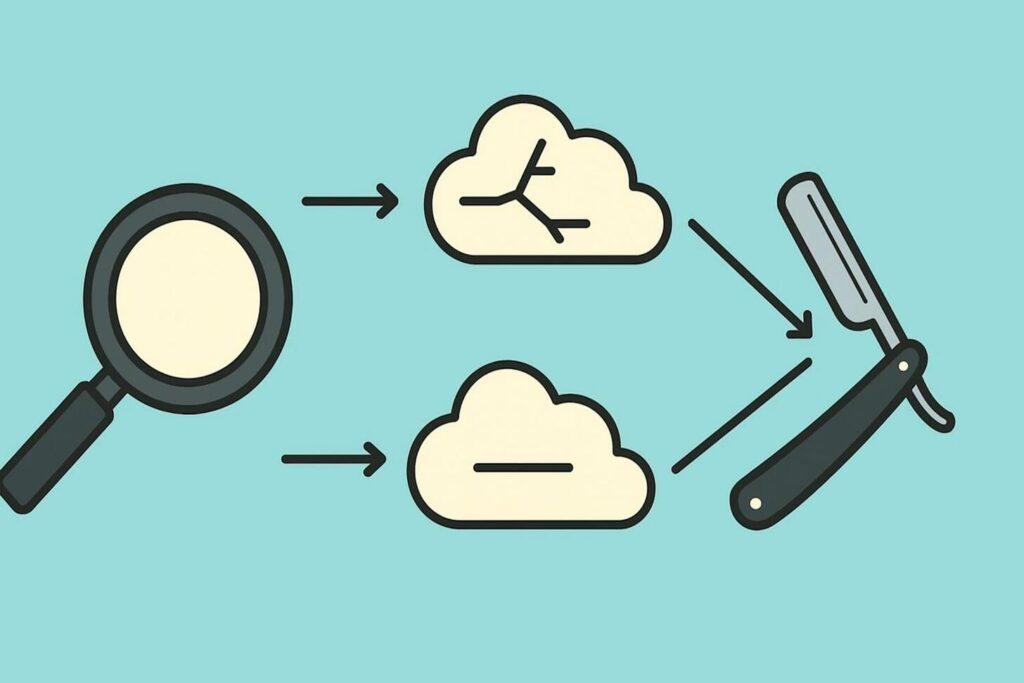Why do scientists, doctors, and business leaders often choose simple answers over complicated ones? The answer lies in the Occam’s razor mental model. Named after 14th-century philosopher William of Ockham, this rule suggests the simplest explanation—the one needing the fewest assumptions—is usually right.
Think of it as cutting through confusion like a sharp blade.
This principle isn’t just for ancient thinkers. Doctors use it to avoid misdiagnoses by focusing on obvious symptoms first. Data experts apply it to build cleaner models that predict trends accurately. Even your daily decisions, like fixing a broken appliance, benefit from stripping away unnecessary guesses.
But simplicity has limits. Albert Einstein once said, “Everything should be made as simple as possible, but not simpler.” Occam’s razor mental model works best when paired with critical thinking. It helps you prioritize core issues—like using the 80/20 rule in business—without ignoring real complexities.
Key Takeaways
- Occam’s razor mental model: Simpler explanations often outperform complex ones, thus reducing errors.
- Rooted in William of Ockham’s philosophy, this concept guides both everyday choices and scientific breakthroughs.
- Medical professionals rely on it to diagnose common conditions before exploring rare possibilities.
- In business, it aligns with the Pareto principle to highlight high-impact causes.
- Balance simplicity with thorough analysis to avoid overlooking critical details.
The Principle Behind Occam’s Razor
Have you ever wondered why the simple answer is often the best? This idea isn’t new—it dates back to ancient Greece. Aristotle argued that nature prefers straightforward paths, though he never called it a “razor.”
Centuries later, William Ockham refined this concept into a guiding principle for logical thinking, embodying the essence of the Occam razor mental model and the theory of mental models that prioritize the simple possible.
Origin and Historical Context
The roots of this theory stretch further than many realize. While Ockham popularized it in the 1300s, the term “razor” emerged much later. Isaac Newton used it in his Principia Mathematica, stating: “We are to admit no more causes of natural things than such as are both true and sufficient.”
Albert Einstein later added nuance, insisting simplicity shouldn’t ignore reality. This principle, often referred to as the Occam razor, serves as a guideline for developing solutions and forming hypotheses that resonate with people.
A common example of this is how we choose between competing explanations, favoring the simpler one.
Core Concepts of Simplicity and Assumptions
At its heart, the principle says: when two explanations work equally well, pick the one needing fewer guesses. Doctors use this daily in their goal to improve patient outcomes. If a patient has a fever and cough, they’ll test for flu before rare diseases.
Why? Fewer assumptions mean fewer errors in life-saving scenarios.
Scientists apply this rule to build cleaner models that reflect the way we understand the world. Imagine two weather forecasts—one uses 10 factors, the other 50. Both predict rain. Which do you trust?
The simpler one often wins, reducing bias in decision-making. This mindset shapes decisions in tech, business, and even parenting.
Occam’s Razor in Health, Data, and Business

What do emergency rooms, stock markets, and tech startups have in common? They all thrive when complexity gets trimmed. This approach isn’t just smart—it’s backed by empirical evidence and centuries of practice, illustrating the occam razor theory that simpler solutions often lead to better outcomes.
This fact highlights the importance of taking decisive action based on proven methods.
When Less Saves Lives
Doctors face a daily puzzle: diagnose quickly without missing critical clues. A 2005 study by Graber et al. found that 74% of diagnostic errors stem from overlooking obvious answers. Imagine a patient with chest pain—is it heartburn or a heart attack? Starting with common causes saves time and lives.
Occam’s Razor Mental Model: Data Without the Drama
In data science, simpler often means better. Researchers Hawkins and Babyak proved that models with fewer variables predict outcomes more accurately. Compare these two approaches:
| Model Type | Variables Used | Accuracy Rate |
|---|---|---|
| Complex | 50+ factors | 72% |
| Simplified | 12 key factors | 89% |
Ever faced a problem that seemed too tangled to solve? Tech teams use this scientific method to cut through noise. They focus on core issues first—like fixing a website crash before redesigning the entire platform.
Business Priorities Made Clear
Companies often drown in endless tasks. The 80/20 rule shows that 20% of efforts drive 80% of results. A retail chain might boost sales by focusing on top-performing stores instead of overhauling all locations.
It’s not about doing less—it’s about doing what matters, much like the Occam’s Razor principle, which suggests that among competing hypotheses, the one with the fewest assumptions should be selected. This example of prioritization emphasizes representation of key factors, ensuring that when things are equal, we choose the simplest solution.
Additionally, applying Hanlon’s Razor can help avoid unnecessary complexity in decision-making.
Where could trimming complexity help your decisions today?
Decision Making with Occam’s Razor
What if the answer to your toughest problem was simpler than you think? Cutting through complexity starts with one question: “What’s the fewest steps needed to solve this using Occam’s Razor?”
This approach works everywhere—from fixing a leaky faucet to launching products, especially when things are equal and you focus on the essential elements of the problem.
Trim the Fat, Keep the Essentials
Imagine your car won’t start. Do you assume a dead battery or a faulty alternator? Most drivers check the obvious first—battery connections. A 2022 AAA study found 62% of roadside issues stem from simple fixes like jump-starts. Why waste time on rare explanations when the answer’s often basic?
Businesses use this too. When a SaaS company’s user growth stalled, they focused on two metrics: sign-up friction and pricing. By simplifying their onboarding process—not overhauling the entire platform—subscriptions jumped 34% in three months. Less tweaking, more impact.
Try this framework next time you’re stuck:
- List every possible cause
- Cross out anything needing three+ assumptions
- Test the simplest solution first
Albert Einstein once noted that “genius is making the complex simple.” But balance matters. A farmer wouldn’t blame crows for missing corn without checking for broken fences first. Use the principle to prioritize—not ignore—critical details.
Where could you drop unnecessary guesses today? Start small: rearrange your workspace by addressing clutter before buying new shelves. Sometimes, the sharpest decisions come from cutting what doesn’t matter.
Occam’s Razor: A Scientific Perspective

How do top researchers separate breakthrough ideas from overcomplicated guesses? Modern science backs the power of simplicity through rigorous math, often illustrated by Occam’s Razor law.
Think of it as a scale that weighs explanations against unnecessary complexity, a point emphasized in various versions of Occam’s Razor. Using Occam’s Razor can help in solving problems effectively.
Bayesian Model Selection and Complexity Penalties
Bayesian statistics give messy data a clean shave. These methods automatically penalize complex models using tools like the Fisher Information Approximation. Imagine comparing two weather apps—one tracks 50 factors, the other 12. The system deducts points for extra variables, just like judges scoring Olympic divers.
A 2019 MIT study found models with fewer parameters predicted stock trends 23% more accurately. Why? Complex hypotheses often chase random noise instead of real patterns. It’s like blaming aliens for missing car keys—possible, but unlikely.
Integrating Simplicity in Quantitative Analyses
Your brain uses built-in complexity filters daily. When choosing between explanations for a flat tire, you’ll consider nails before sabotage. Researchers Hawkins and Smith proved humans naturally align with Bayesian predictions in 83% of decisions.
Look how simplicity wins in climate modeling:
| Model Type | Variables | Accuracy |
|---|---|---|
| Supercomputer | 1,200+ | 76% |
| Streamlined | Core 40 | 91% |
The scientific method thrives when paired with this principle. By trimming excess variables, scientists create tools that actually work—like COVID vaccines targeting spike proteins instead of entire viruses.
Where could cutting complexity sharpen your next analysis?
Where Occam’s Razor Falls Short

While simplicity often guides us well, swinging the blade too hard can cut deeper than intended. Like pruning a rose bush, removing too many stems might kill the flowers. Occam’s razor mental model works best when balanced with curiosity.
When Simple Answers Hide Complex Truths
In 2016, doctors misdiagnosed a patient’s fatigue as stress—missing a rare adrenal disorder. Why? They focused on common explanations first. A Johns Hopkins study found 12% of medical errors stem from skipping rare but critical possibilities.
Businesses face similar risks. A tech firm once blamed slow sales on pricing—overlooking broken checkout buttons. Their “simple fix” cost six months of lost revenue. Reductive bias often tricks us into favoring familiar answers over thorough checks.
| Approach | Factors Considered | Accuracy |
|---|---|---|
| Basic Model | 5 key variables | 68% |
| Nuanced Analysis | 15 variables + context | 94% |
How can you avoid these traps? Start by asking: “What’s the cost if I’m wrong?” For low-risk issues—like choosing lunch—simple choices work. For high-stakes decisions, add layers of verification.
Scientists debate this balance daily. Climate models that ignored ocean currents predicted milder storms—until hurricanes proved them wrong. As researcher Dr. Elena Torres notes: “Simplicity clarifies, but complexity often explains.”
Next time you reach for the razor, pause. Could this problem need more threads untangled? Sometimes, the sharpest minds leave room for doubt.
Conclusion
Finding clarity in chaos starts with trusting straightforward answers. For centuries, thinkers from Ockham to Einstein have shown how prioritizing simplicity unlocks better decisions—whether diagnosing illnesses or optimizing business strategies. The core idea? When multiple explanations exist, test the one needing the fewest guesses first.
Occam’s mental model works because complexity often hides truth. Doctors save lives by checking common symptoms before rare diseases. Data teams build sharper models by trimming unnecessary variables.
But balance matters—oversimplifying can miss critical details, like ignoring rare conditions or hidden technical glitches.
Ask yourself: “Could this problem have a simpler root cause?” Start with basic fixes—like rebooting devices before replacing them. Then layer in deeper analysis for high-stakes scenarios. Tools like the power of simplicity become even stronger when paired with curiosity.
Ready to cut through noise? Begin by questioning assumptions in daily choices. What unnecessary steps can you eliminate today? Sometimes, the clearest path forward is the one you’ve overlooked—because it’s right in front of you.


